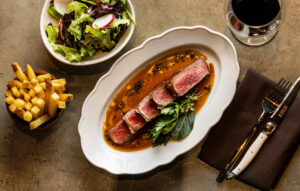
There’s a tasty secret chefs know: Use lots of salt.
Along with butter and cream, salt is one of the most important ingredients in their kitchen arsenal. Not just for seasoning, but to bring out the natural flavors in every dish — from meats to dessert.
But not the salt most of us know. In fact, iodized table salt — the stuff we all have in our cupboards — is unwelcome on the menus of top toques. Most would rather lick the soles of their kitchen clogs than eat the fine-grained, heavy-processed salt with all the taste of the cardboard container it comes in.
Instead, they reach for more flavorful, textural seasoners, from simple kosher salt to exotically-infused finishing salts to enhance their dishes.
It’s a powerful tool. One of the five flavor components (along with sweet, bitter, sour and umami), a fail-proof preservative and necessary chemical for human survival. Salt’s colorful story puts it at the forefront of civilizations, the root of many ancient wars, a source of money and medicine throughout the ages. It’s the root of the word “salary”, from the Latin salarium — the salt rations paid to soldiers. And only in recent history has it been so readily available that we all but overlook it.

Far more than just something to shake over your hash browns, however, salt is becoming a gourmet commodity in its own right.
Beyond simple kosher (usually a larger-grained, unadulterated version of table salt mined from deep underground) are dried sea salts. Made from evaporated sea water, they’re a bit more complex, retaining many minerals and other local goodies like clay or volcanic ash. With colors ranging from black and grey to pink, they’re table salt’s more flamboyant sibling. Some popular types include French Fleur de Sel, Hawaiian Red Salt, Maldon salt from the UK and hand-harvested sea salt from Japan. Also wildly popular is Himalayan Pink Salt, mined from ancient sea beds in the Himalayan Mountains.
Though their implied health benefits are sometimes suspect, the lack of additives and processing do appeal to many.
One step further are finishing salts — usually sea salt enhanced with sweet or savory herbs, mushrooms, truffles, citrus or other flavors (heirloom tomato?). They’re mostly used in small quantities as garnish, imbuing dishes with a hint of contrast. Gourmet purveyors charge a mint for these — Dean and Deluca’s white truffle salt is a hefty $75 per pound.
Got a hankering for some of these savory seasonings? Many can be found at local grocers (Whole Foods and Olivers), gourmet purveyors like Dean and Deluca (Napa) or Michael Chiarello’s new NapaStyle store in Yountville, or by mail order.
So make like a chef and toss that shaker aside. Instead, grab a pinch of these sultrier seasonings:
– Saltistry (Los Angeles, www.saltistry.com or at NapaStyle) has some of the wildest finishing salts, featuring flavors like Lemon Thyme, Apricot, Tangerine, Fennel Pollen and Smoked Salish. They come in adorable little sampler packs that make them portable pinches for any meal.
– Dean and Deluca (St.Helena, www.deananddeluca.com) have a bevy of flavored salts (White Truffle, Black Lava, Curry, Thai Ginger and Chili Verde to name a few) available by the ounce.
– NapaStyle (6525 Washington St, Yountville – (707) 945-1229) also has a variety of infused finishing salts, including Cranberry Gray Sea Salt that’s perfect for topping ice cream.
– Himalayan Pink Salt (Sur La Table) $13.95 for a chunk you can grate yourself.
– Palm Island Hawaiian salts: Red Gold Sea Salt, Bamboo Jade (Whole Foods)
– Spanish Smoked Seasoned Salt with sweet paprika from Urban Accents (Whole Foods)
– Citrus Sea Salt from the Fig Store/Girl and The Fig (www.thegirlandthefig.com)

Get it at: Hana Japanese (101 Golf Course Dr, Rohnert Park). Grilled cuttlefish or Tempura Whiting Fish with tea salt.
Or, make your own. Start with a high-grade sea salt and add your favorite spices (I used Chinese Five Spice Powder for one and Meyer Lemon Peel for another). Make sure the add-in is fairly dry and simply mix together to taste. If the spice is a bit chunky, process in a food processor. Yeah, it’s that easy.









